Upton Grey parish church

St Mary's Church
Upton Grey is a small rural parish covering over 2,500 acres of mostly arable land in the chalk downland of north east Hampshire. It has 27 listed buildings, ranging from mediaeval to 18th century. In Saxon times the village of Upton Grey was two separate manors:- Aoltone (now Upton), the Grey being added in the 13th century when the manor was acquired by the de Grey family, and Odingetone (now Hoddington). The population in 1086 was about 175 in 34 dwellings and is now over 600 in some 200 dwellings.
The Saxon church mentioned in the Domesday Book in 1086 was replaced in about 1120 in the reign of Henry 1, a son of William the Conqueror. Soon after 1200, in the reign of King John, a new chancel was added and a tower was built where the old chancel had been. A small piece of almost unreadable text has been preserved on the west wall of the tower. The lettering is English from circa 1340, which makes it extremely early for an English language text. The full wording was most likely to have been “For God’s love beware by me” and to have accompanied a purgatorial or memento mori scene. The Hoddington Aisle was built in 1715 for John Limbrey, Lord of the Hoddington Manor.
During the Civil War, the churchwardens and parishioners of Upton Grey signed a certificate to the effect that most of them had suffered loss by the “spoyling of moundes” around the churchyard, and that the mounds of the church and parsonage had also suffered. This damage was caused by the soldiers quartered in the village for 12 days and nights, during the siege of Basing House.
Content derived during research for new VCH Hampshire volume, Old Basing, Steventon and surrounding parishes


